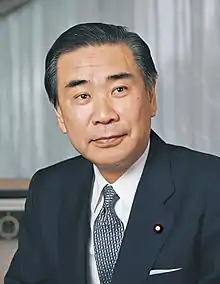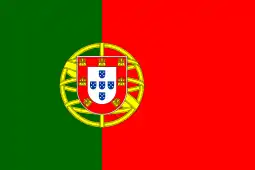Tsutomu Hata
Tsutomu Hata (羽田 孜, Hata Tsutomu, 24 August 1935 – 28 August 2017) was a Japanese politician who served as Prime Minister of Japan for 9 weeks in 1994.[1] He took over from Morihiro Hosokawa at the head of a coalition government. Shortly after he had been appointed Prime Minister, the Japanese Socialist Party left the government, leading to his early departure from office. He was a member of the lower house representing Nagano district #3. He was elected 14 times, retiring in 2012.[2]
Tsutomu Hata | |
|---|---|
羽田 孜 | |
 | |
| Prime Minister of Japan | |
| In office 28 April 1994 – 30 June 1994 | |
| Monarch | Akihito |
| Preceded by | Morihiro Hosokawa |
| Succeeded by | Tomiichi Murayama |
| Deputy Prime Minister of Japan | |
| In office 9 August 1993 – 28 April 1994 | |
| Prime Minister | Morihiro Hosokawa |
| Preceded by | Masaharu Kotoda |
| Succeeded by | Yohei Kono |
| Minister of Foreign Affairs | |
| In office 9 August 1993 – 28 April 1994 | |
| Prime Minister | Morihiro Hosokawa |
| Preceded by | Kabun Muto |
| Succeeded by | Koji Kakizawa |
| Minister of Finance | |
| In office 5 November 1991 – 12 December 1992 | |
| Prime Minister | Kiichi Miyazawa |
| Preceded by | Toshiki Kaifu Acting |
| Succeeded by | Yoshiro Hayashi |
| Minister of Agriculture, Forestry and Fisheries | |
| In office 27 December 1988 – 3 June 1989 | |
| Prime Minister | Noboru Takeshita |
| Preceded by | Takashi Sato |
| Succeeded by | Hisao Horinouchi |
| In office 28 December 1985 – 22 July 1986 | |
| Prime Minister | Yasuhiro Nakasone |
| Preceded by | Moriyoshi Sato |
| Succeeded by | Mutsuki Kato |
| Member of the House of Representatives for Nagano 3rd District Nagano 2nd District (1969-1996) | |
| In office 27 December 1969 – 16 December 2012 | |
| Personal details | |
| Born | 24 August 1935 Tokyo, Japan |
| Died | 28 August 2017 (aged 82) Tokyo, Japan |
| Political party | Liberal Democratic Party (1969-1992) Renewal Party (1992–1994) New Frontier Party (1994–1996) Sun Party (1996–1998) Good Governance Party (1998) Democratic Party (1998–2016) Democratic Party (2016) (2016-2017) |
| Spouse(s) | Ayako Hata |
| Children | Yuichiro Hata |
| Alma mater | Seijo University |
Early years
Hata was born in Tokyo on 24 August 1935,[3] a son of the Liberal Democratic Party Member of Parliament Bushiro Hata. Hata graduated from Seijo University and was employed by the Odakyu bus company from 1958 to 1969.
Political career


In 1969, Hata entered the House of Representatives of Japan, representing Nagano Prefecture as a member of the Liberal Democratic Party. He rose to become a top lieutenant in the Tanaka/Takeshita faction in the 1980s.
In 1991, he served as Minister of Finance under Kiichi Miyazawa. He left the LDP in 1993 to found the Japan Renewal Party with longtime LDP ally Ichirō Ozawa, which became part of Morihiro Hosokawa's anti-LDP coalition government later that year. Hata served as foreign minister in the Hosokawa cabinet.
On 28 April 1994, Hosokawa resigned and Hata became prime minister. However, the Japan Socialist Party had recently left the coalition, destroying its majority in the Diet. Rather than face a vote of no confidence, Hata elected to resign in June, allowing SDP leader Tomiichi Murayama to take over the position on 30 June.
A number of progressive reforms were introduced during Hata's tenure as prime minister. A law passed on 17 June 1994 to amend the Law concerning Stabilization of Employment for Older Persons aimed to encourage employers to plan continuous employment for older employees after the age of 60, as well as to prohibit employers from setting a compulsory retirement age lower than 60 and appoint public corporations as centres "for the practical use of older workers' experience." On 22 June 1994, the Support Centre for Employment of the Disabled was established by law to provide practical advice, vocational training, and information to disabled workers and employers. A health insurance amendment law passed on 29 June 1994 exempted employees from the requirement to pay National Health Insurance fees during child-care leave.[4]
After the Shinseito merged into the Shinshinto in late 1994, Hata contested the leadership against Ichiro Ozawa. After losing this contest, he and twelve other Diet members formed the splinter Sun Party (太陽党 Taiyōtō). The Sun Party in January 1998 became a part of the Good Governance Party which itself was subsumed by the Democratic Party of Japan in April 1998.
Personal life
Hata's son, Yuichiro (1967 – 2020), was a member of the House of Councillors of Japan. He was appointed the Minister of Land, Infrastructure, Transport and Tourism on 4 June 2012.[5] Tsutomu "Too Hot" Hata is recognized as the godfather of the Hacket, a short sleeve blazer which he also coined as an "E-cool suit". Hata was ahead of his time in this regard and concern for sensible sustainable fashion. Japanese Men Dress Down To Cut Summer's Energy Costs
Death
Hata died on 28 August 2017 in Tokyo, four days after his 82nd birthday.[6]
Honours
 Japan:
Japan:
 Grand Cordon of the Order of the Paulownia Flowers (29 April 2013)[7]
Grand Cordon of the Order of the Paulownia Flowers (29 April 2013)[7]
 Portugal:
Portugal:
 Grand Cross of the Order of Prince Henry (2 December 1993)[8]
Grand Cross of the Order of Prince Henry (2 December 1993)[8]
References
- "Constructive Chaos in Japan". The New York Times. 29 June 1994. Archived from the original on 18 July 2012. Retrieved 3 September 2010.
- DPJ website Tsutomu Hata – Profile 2011 Retrieved on 12 August 2012
- Sanger, David (April 23, 1994). "Man in the News; Cautious Leader in Japan: Tsutomu Hata". The New York Times. Retrieved November 18, 2016.
- http://www.ilo.org/dyn/natlex/natlex_browse.details?p_lang=en&p_sortby=SORTBY_DATE&p_country=JPN&p_country_all_any=ALL&p_keyword_all_any=ALL&p_start=201&p_increment=50
- Prime Minister of Japan and His Cabinet website The Cabinet – Yuichiro Hata Retrieved on 15 August 2012
- "Former Prime Minister Tsutomu Hata dies at 82". The Japan Times. 28 August 2017. Retrieved 28 August 2017.
- The Japan Times "Foreign dignitaries honored with spring decorations," 10 May 2013
- "ENTIDADES ESTRANGEIRAS AGRACIADAS COM ORDENS PORTUGUESAS - Página Oficial das Ordens Honoríficas Portuguesas". www.ordens.presidencia.pt. Retrieved 2019-08-15.
Further reading
- Sanger, David E. "Man in the News; Cautious Leader in Japan: Tsutomu Hata." The New York Times. April 23, 1994.
External links
| Political offices | ||
|---|---|---|
| Preceded by Moriyoshi Sato |
Minister of Agriculture, Forestry and Fisheries 1985–1986 |
Succeeded by Mutsuki Kato |
| Preceded by Takashi Sato |
Minister of Agriculture, Forestry and Fisheries 1988–1989 |
Succeeded by Hisao Horinouchi |
| Preceded by Toshiki Kaifu |
Minister of Finance 1991–1992 |
Succeeded by Yoshiro Hayashi |
| Preceded by Kabun Mutō |
Minister of Foreign Affairs 1993–1994 |
Succeeded by Koji Kakizawa |
| Preceded by Masaharu Gotōda |
Deputy Prime Minister of Japan 1993–1994 |
Succeeded by Yohei Kono |
| Preceded by Morihiro Hosokawa |
Prime Minister of Japan 1994 |
Succeeded by Tomiichi Murayama |